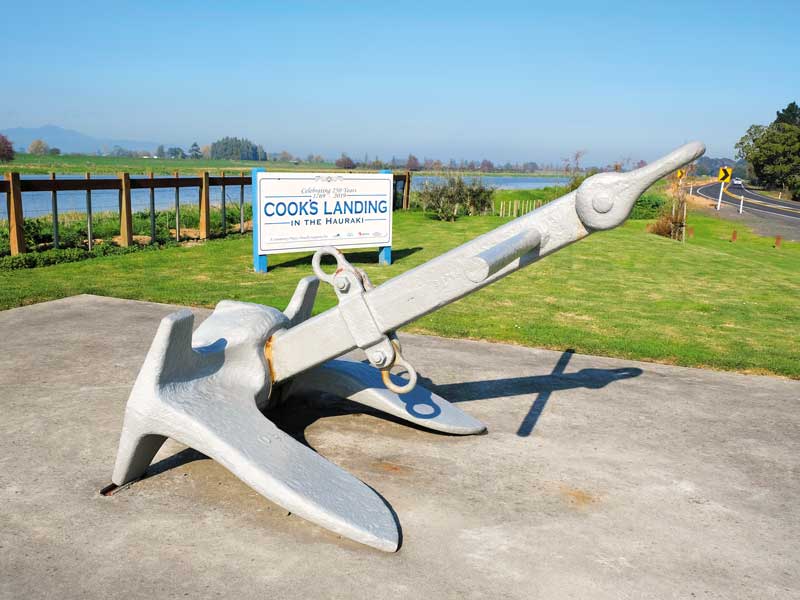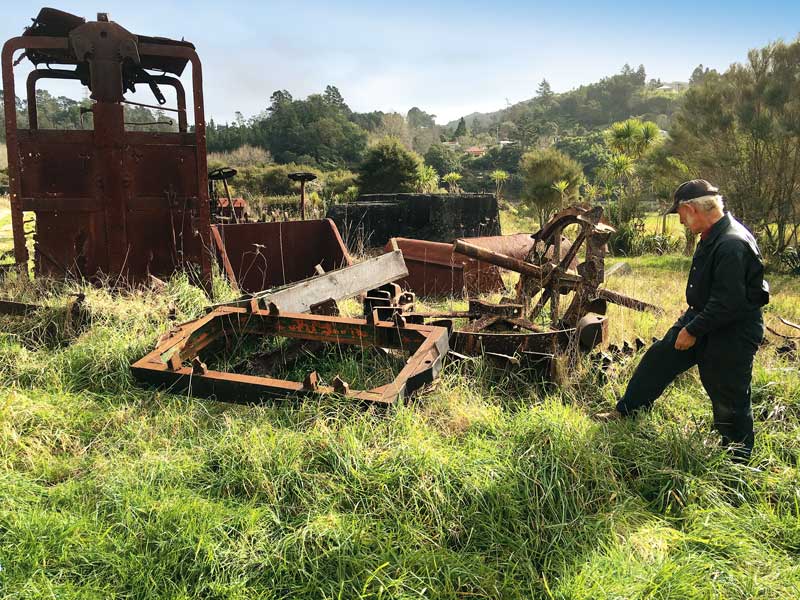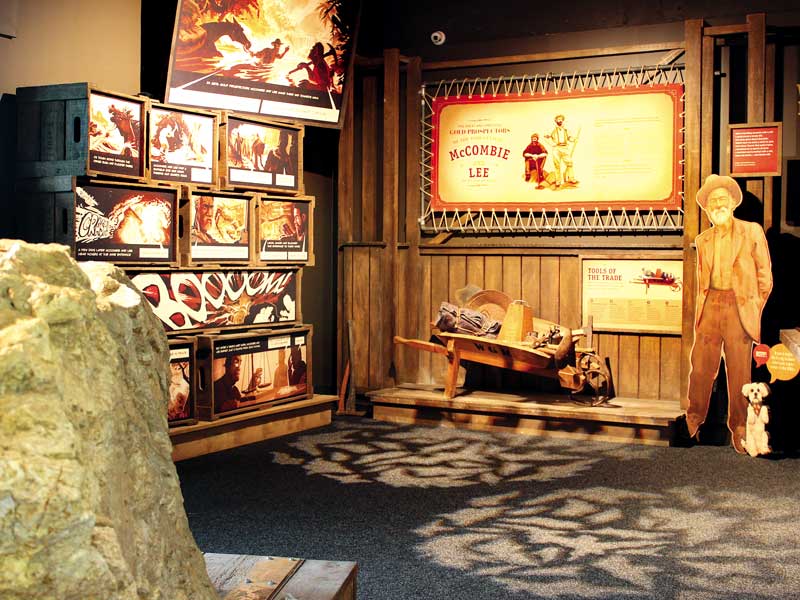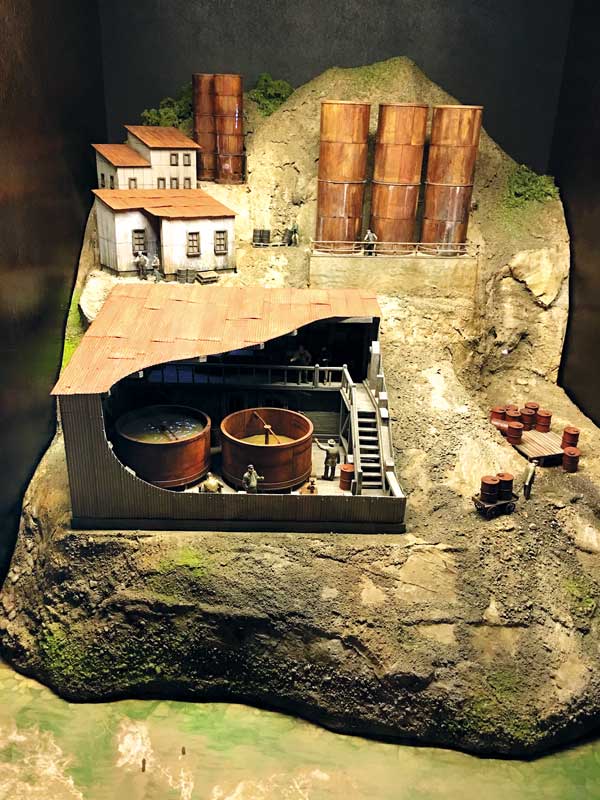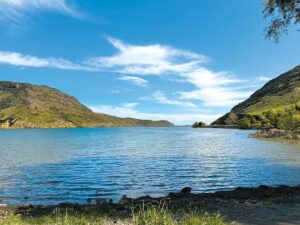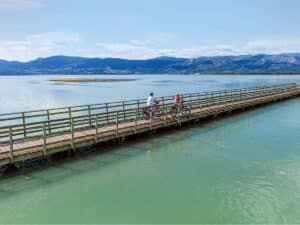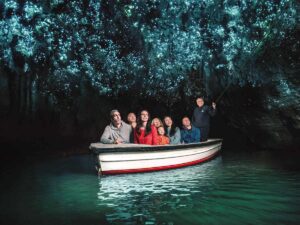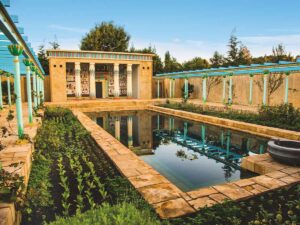10am
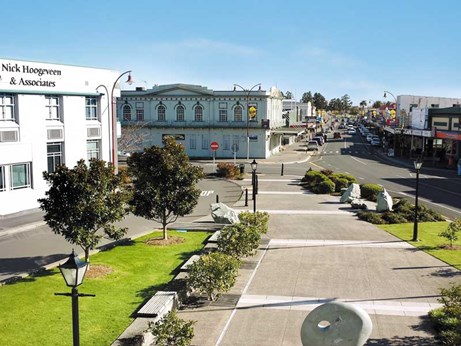 |
The main street of Paeroa |
Approaching Paeroa from the north, SH2 runs parallel to the Waihou River, which tips into the Firth of Thames. I hadn’t known this waterway was navigable until, at Netherton, I located a large mounted anchor, which marks the fact that in 1769 Captain Cook had plied the river in a tender looking for spar timber. Jump forward a hundred years and Paeroa had become an important port.
11 am
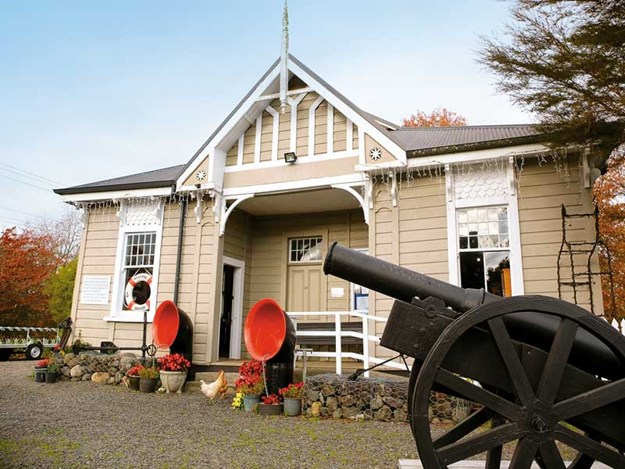 |
The Historical Maritime Museum in the old Karangahake post office building |
The town is defined by its history. On the bank of a Waihou tributary is the Historical Maritime Museum housed in the old Karangahake Gorge Post office (1887). Here the town’s waterborne history is well documented in comprehensive accounts and model displays.
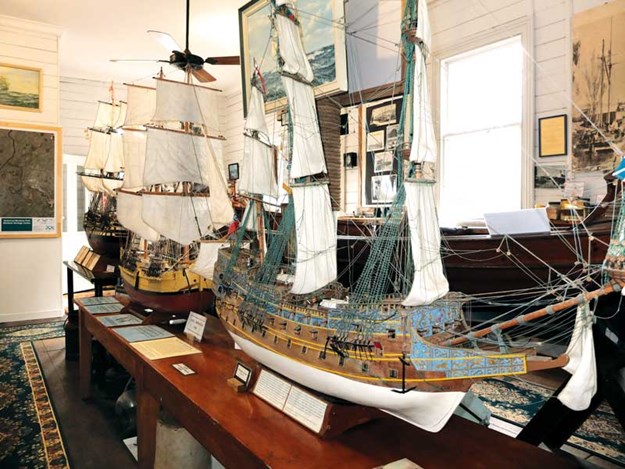 |
Model ships on display in the Historical Maritime Museum |
During the mid-19th century, when thousands of souls with gold dust in their eyes crammed into the mines of Waihi, Karangahake and Thames, the Paeroa Port was in full swing. There’s little sign of it now.
12.30 pm
We found The Refinery cafe on Willoughby Street. True to the name, it’s an industrial building of massive concrete walls and a double-height stud capped with huge timber beams. It was built in 1914 to refine bullion from the mines.
Now, we sat in comfortable armchairs in the pleasant ambience created by a large fire. The coffee was good and the wholesome foods were all made on site.
Bill ordered a Cornish pasty, which fitted the mining theme. I chose a pear and ginger scone, which was as interesting as it sounds. The cafe was conducive to a long lunch, but we had other things to do.
2pm
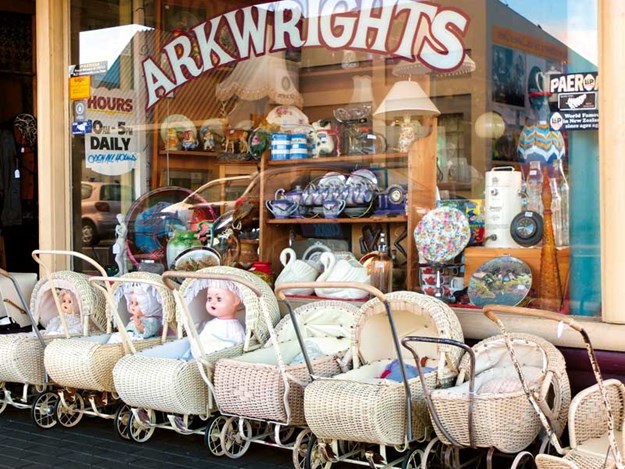 |
One of Paeroa’s fully laden antique and collectables shops |
I dragged Bill along to the Paeroa Museum because I’d heard it has the largest collection of Doulton china in the Southern Hemisphere. He seemed grateful that it wasn’t open.
Instead, we investigated the Hauraki RV village on the outskirts of town. It’s an interesting concept. Eventually there will be 26 houses on separate titles, each with a roomy parking area for an RV.
2.45pm
We attended to the housekeeping: a visit to the re-sited dump station and a quick spin for wet clothing at the laundromat that also has hot showers.
While that was happening, I found Burton’s Butchery on Molly’s Corner, which has an extensive and interesting carnivore collection, including black pudding and mussel sausages.
4.30pm
Time to suss out a park for the night. There were no than less than five free or low-cost parking areas: the RV Centre, the railway reserve, the Maritime Park, the Paeroa Golf Club, and the council car park.
No surprise that we settled for the golf club. Bill harboured the hope of a few holes in the morning. In his dreams! It was a bit out of town but a lovely quiet spot against a backdrop of hills.
I walked a few of the tree-dotted fairways with Pernille from Denmark, who’d parked near us in her hired van. Then Bill and I cooked the mussel sausages to eat with a salad and mashed potato. It was an interesting culinary experience.
Saturday
10 am
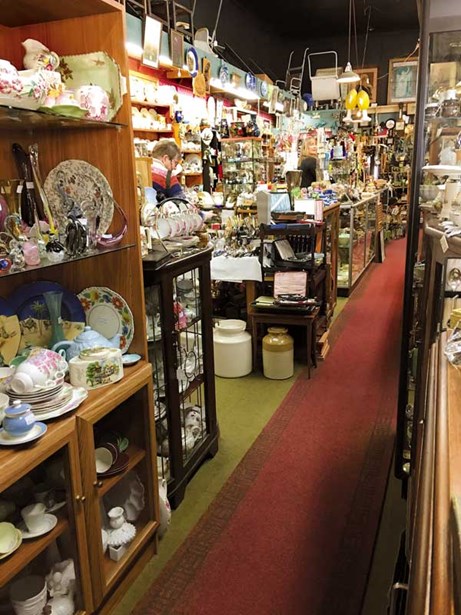 |
A browsing bonanza for antique lovers |
A fog had rolled in during the night and we drove through a ghostly landscape to the brighter lights of town. More history is evident on Paeroa’s main street, where there are some attractive old buildings and a number of retro and vintage shops and antique dealers. One might wander around these for hours, but I’m not really the one.
Some of the boutiques were so stuffed with teetering breakables I was terrified of knocking them off their perches. Other punters seemed intent on buying, but for me, picking my way along the aisles of ancient curiosities was more of a trip down memory lane.
10.45 am
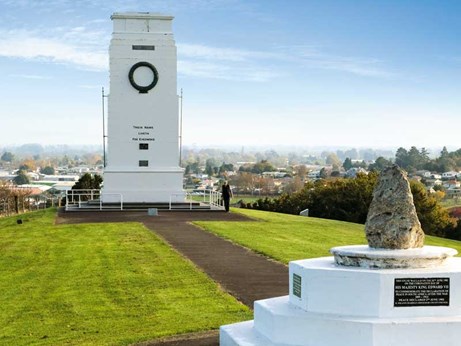 |
War memorials on Primrose Hill, Paeroa |
The fog had lifted and we walked up Primrose Hill to a tall monument recording the two world wars and a much smaller one commemorating the Boer War and George Bradford, the first soldier of any New Zealand military force to be killed overseas. I presume he lived in Paeroa. Down in the valley the townscape was furred by leafless trees.
12.30 pm
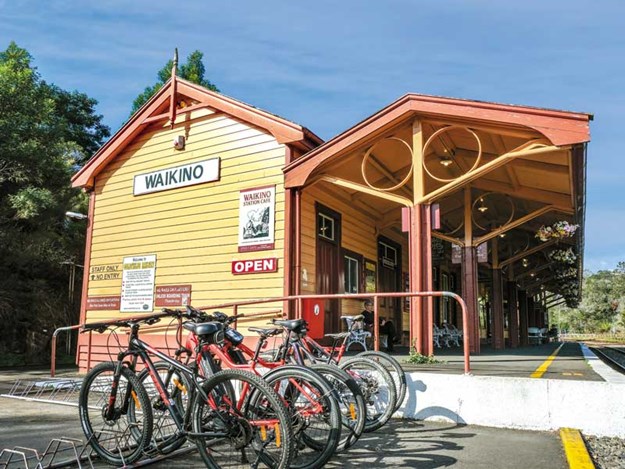 |
The Waikino Station is typical of early railway architecture |
Karangahake Gorge, Waihi and Paeroa are glued together by their past and we drove west on SH2. After the flatness of the Hauraki Plains, the high cliffs of the gorge were like a welcoming hug.
In need of sustenance, we called in to the historic Waikino Railway Station (transplanted from Paeroa), which is furnished as it might have been in the early 1900s.
The atmosphere was charming and cosy and quite unexpected. A fire burned in the old brick fireplace, the tables were laid with lace cloths, and all the food was made in the kitchen (aka the engine room).
1.30 pm
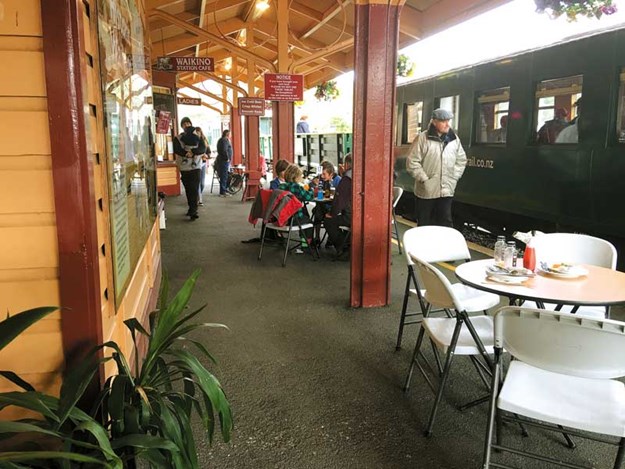 |
Train stop at the old Waikino Station |
Above the cafe’s fireplace hangs a large photograph of the Victoria Battery just across the road. It was once the largest quartz crushing/gold extraction plant in the world. We walked among the wreckage and residue of this huge complex that looks as if a giant has thrown his toys out of the cot and left them to rust.
A cold wind was rattling through the gorge. We took a quick look at the working stamper in the museum in the old transformer building and hastened back to the shelter of the car.
2.30pm
In Waihi we discovered that we had just missed the bus for the tour which goes to the working Correnso underground gold mine. But in a Waihi cafe I met an old miner who had seen a bit of metal in his time. He told me that the Martha mine will be turned into a recreational lake when the gold’s gone. “I wouldn’t buy a boat just yet,” he grinned.
3.15pm
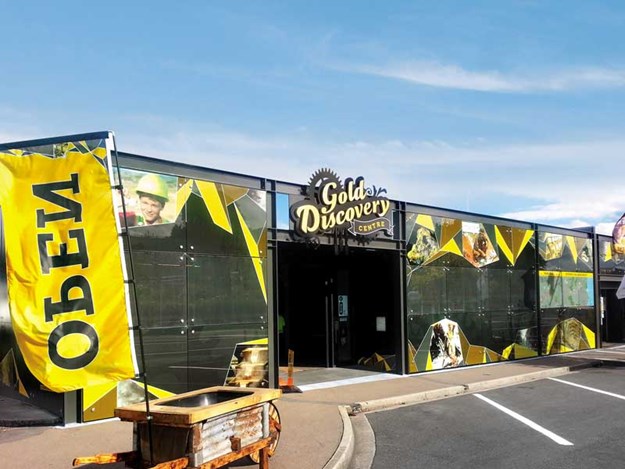 |
The Gold Discovery Centre in Waihi is a good overview of the area’s history |
We took a few photographs of the old Cornish Pumphouse on Martha’s lip and then moved out of the cold into the marvellous Gold Discovery Centre across the road. This is not so much a museum as an experience. I played two-up with a tough ‘ghost’ miner and had my thumb cut off when I owed him money.
I was chatted up by two hologram miners who encouraged me to handle a drill, and in the Ghost Theatre was introduced to a hologram called Tom, and his girlfriend Essie. They were arguing about the infamous miners’ strike in 1912. The vignette was so realistic, I almost intervened.
4.30 pm
Calling it a day, we drove to Waihi Beach RSA Club, where RVers are welcome to park on the expansive hard-surface area behind the building. In the lively restaurant the food was wholesome, hearty and reasonably priced. We joined two other RV couples and settled in for a congenial evening.
Sunday
10am
No gold weighed down our pockets as we left the area, but in terms of discovery, we felt the richer for having been there.

